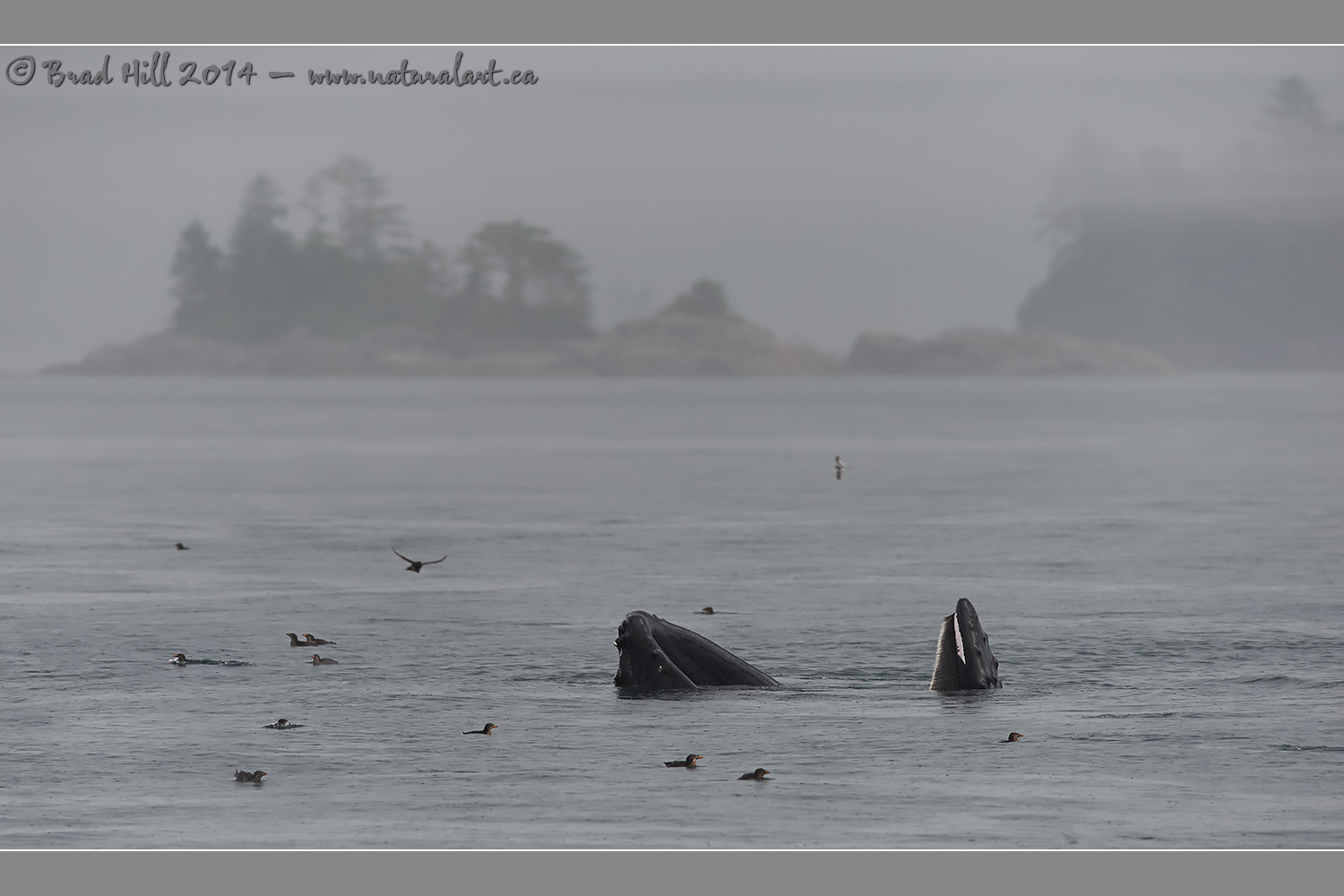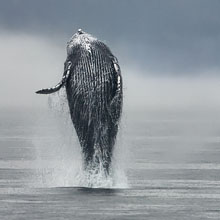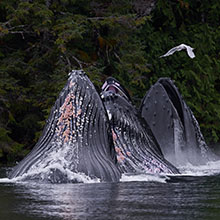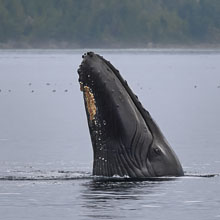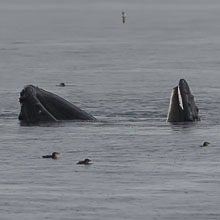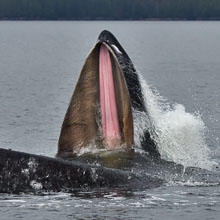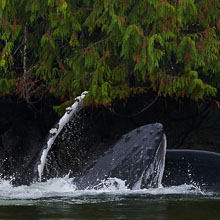Availability: Undetermined - Enquiries?
In the Field
The Assemblage. Northern Vancouver Island, BC, Canada. August 29, 2013.
Anyone who has spent time in the proximity of Humpback Whales on North America's Pacific Coast should be able to relate to this shot. One of the key food/energy sources that drives the near-shore marine ecosystem is the presence of herring and other small "bait-fish". Organisms of all sizes - from small seabirds like the Rhinoceros Auklets shown here (and the Fork-tailed Storm-Petrel flying behind the whale in the "midground") through to massive 40-ton Humpback Whales - are absolutely dependent on them. Find a whale feeding on herring and you'll almost always birds working the herring over as well. So...what comes first - the chicken (the auklets) or the egg (in this case the whale - which is one huge egg!)? Well...after seeing dozens of these and other mixed-species assemblages feeding on herrings I'd have to say that more often or not it's the chicken (the birds) that come first! But once in a while you will see the odd whale ravenously sucking in the herring in blissful solitude (for at least a few minutes until the eagle-eyed birds descend upon the scene).
I know many photographers who shy away from shooting in "flat" lighting like that in this scene. I personally like the moodiness of overcast, misty scenes but fully recognize that they can be difficult to work with. The challenge in making them interesting - and appearing as seen by you in the field - is normally not in the image capture phase of the process (though some variables of that process - such as producing the most appropriate depth-of-field - CAN be important). In my mind the key to making these type of images work is in the post-processing - and specifically in the photographer's ability to separate out (or "tease out") the subtle tones that the camera's sensor DID record but often don't show by "default". Probably the most important skill for teasing out these small tonal differences is knowing how to make highly selective tone curve adjustments. In this image I had to do this in several places - including on the dark-on-dark tones inside the whale's mouth; on the dark baleen plates on the whale's upper jaw (right side of frame); and on the layered clouds floating in front of portions of the background islands. Changes like this are best made either during conversion of raw files or when editing a 16-bit version (TIFF or PSD) of the original file. If one is shooting JPEG's it's real hard to make images like this work - unless you have your camera's "styles" or "Picture Control" settings dialed in just perfectly AND your initial exposure is spot-on you likely won't have the ability to pull this kind of detail out of an 8-bit JPEG file.
Here's a 2400 pixel version of this one for you to view:
• The Assemblage: Download 2400 pixel image (JPEG: 766 KB)
ADDITIONAL NOTES:
NOTE 1: This image - in all resolutions - is protected by copyright. I'm fine with personal uses of it (including use as desktop backgrounds or screensavers on your own computer), but unauthorized commercial use of the image is prohibited by law. Thanks in advance for respecting my copyright!
NOTE 2: This image was captured during my "Humpbacks, Orcas, Sea Lions & More!" photo tour in the summer of 2013. Each year I offer trips into two different parts of the Great Bear Rainforest as well as one to photograph aquatic mammals and oceanscapes near the northern tip of Vancouver Island. And, in selected years, I also offer photo tours to locations to capture other highly sought-after subjects, such as various owl species of the boreal forest and wildlife of Canada's Arctic. Details about these trips can be found on the Photo Tours page of this website.
NOTE 3: Like all wildlife photographs on this website, this image was captured following the strict ethical guidelines described in The Wildlife FIRST! Principles of Photographer Conduct. I encourage all wildlife photographers to always put the welfare of their subjects above the value of their photographs.
Behind the Camera
The Assemblage. Northern Vancouver Island, BC, Canada. August 29, 2013.
Digital Capture; Compressed RAW (NEF) 14-bit format; ISO 250.
Nikon D4 paired with Nikkor AF-S 400mm f2.8 VR lens - hand-held from sailboat. VR on and in normal mode.
1/1250s @ f5.6; -0.33 stop compensation from "recommended" matrix-metered exposure setting.
At the Computer
The Assemblage. Northern Vancouver Island, BC, Canada. August 29, 2013.
RAW Conversion to 16-bit TIFF, including first-pass/capture sharpening using Capture One Pro version 7. Two raw variants (different versions of a single raw capture) processed, differing by a total of 0.5 stops in exposure.
Further digital corrections on resulting 16-bit TIFF files using Adobe's Photoshop CC and Light Crafts Lightzone. Photoshop adjustments included compositing (blending) of the two output files from the raw converter, further slight exposure adjustments, selective desaturation of colors, and selective sharpening for web output. Final minor selective tone-tweaks performed using tone-mapping tools of Lightzone.
Conservation
The Assemblage. Northern Vancouver Island, BC, Canada. August 29, 2013.
Ten percent of the revenue generated by this image will be donated to Raincoast*.
Species Status in Canada**: Threatened - North Pacific population (May 2003).
Humpback Whales (Megaptera novaeagnliae) are active, acrobatic whales that can throw themselves completely clear of the water (a behaviour known as breaching) and will swim on their backs with both flippers in the air. Humpbacks are large (up to 14m - or 46 feet - in length and 40 tonnes in weight) and with huge flippers.
Humpbacks are found in tropical, temperate, and sub-polar waters around the world. They are found on both the east and west coasts of North America. The North Pacific population has been estimated at between 6,000 and 8,000 individuals, but only a few hundred of these are found in the waters off the coast of British Columbia.
While Humpbacks are recovering from the damage done to their populations by commercial fishing, the are still subject to a variety of threats from human activities, including becoming entangled in fishing nets, noise and chemical pollution and habitat destruction.
*The Raincoast Conservation Society (and Foundation) is an effective and efficient organization that has been fighting for protection of this unique habitat. If you are looking for a meaningful way to contribute to the conservation of this amazing ecosystem, Raincoast will provide maximal "bang" for your conservation dollars.
**as determined by COSEWIC: The Committee on the Status of Endangered Wildlife in Canada












